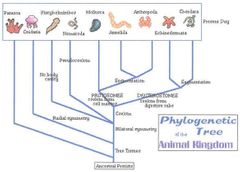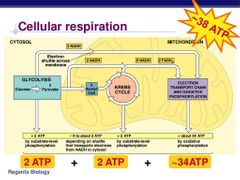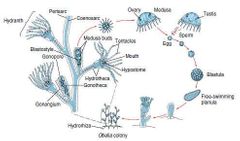![]()
![]()
![]()
Use LEFT and RIGHT arrow keys to navigate between flashcards;
Use UP and DOWN arrow keys to flip the card;
H to show hint;
A reads text to speech;
68 Cards in this Set
- Front
- Back
|
Phylum porifera |
Synapomorphies: water pumping system using choanocytes, spicules |
|
|
Phylum porifera |
Terms and structures- spongocoel, osculum, incurrent canals, asconoid, syconoid, leuconoid |
|
|
Phylum Cnidaria |
Synapomorphies: cnidocytes, nematocysts, radial symmetry |
|
|
Phylum Cnidaria |
Terms and structures-polyp and medusae stages |
|
|
9 Major Phylum |
Porifera, Cnidaria, Platyhelminthes, Nematoda, Annelida, Mollusca, Echinodermata, Arthropoda, Chordata |
|
|
Phylum Porifera |
Asconoid -simple, spongocoel2. Synconoid - spongocoel with invaginated chanels3. Leuconoid - complex, canals and chambers |
|
|
Porifera Class Demospongiea |
1. Siliceous spicules2. not 6 rayed3. only leuconoid |
|
|
Porifera Class Calcarea |
1. Straight monoaxon spicules2. spicules have 3-4 rays3. can be asconoid, synconoid, or leuconoid |
|
|
Porifera Class Hexactinellidae |
Glass sponges1. siliceous spicules2. 6 rayed spicules3. trabecular reticulum - one large, continuous tissue |
|
|
Cnidaria Class Hydrozoa |
Colonial Jellies1. Velum in medusa2. Medusae produced by lateral budding |
|
|
Cnidaria Class Cubozoa |
Box Jellies1. Boxlike medusa2. four evenly spaced tentacle clusters3. complex, well developed eyes |
|
|
Cnidaria Class Scyphozoa |
Bell/Cup Jellies1. Strobilation - asexual repro via division of body segments |
|
|
Phylum Ctenophora Class Tentaculata |
Comb jellies, Synapomorphies1. eight comb rows2. colloblasts3. complete gut |
|
|
Cnidaria Class Anothozoa |
Flower animals/ Sea anemones1. no medusa stage2. reproduce by budding3. hexaradial |
|
|
Phylum Platyhelminthes |
most possess a protonephridic excretory system Characterized by acoelomate, triploblastic, incomplete gut |
|
|
Phylum Platyhelminthes Class Tubellaria |
highly cephalized with eye spots (oceli) incomplete gut, flame cells osmoregulate |
|
|
Phylum Platyhelminthes Class Trematoda |
Synapomorphy - possess oral and ventral suckers (no hooks). Charcterized by being parasitic complete life cycle ( intermediate host mollusc definitive host vertbrate, body covered in tegument that lacks cilla |
|
|
Phylum Platyhelminthes Class Cestoda (Tapeworms) |
Synapomorphies- body form 3 tape like regions (scolex, neck, and strobila. Scolex with suckers and rostellum with hooks, strobila composed of many proglottids. Lack mouth and digestive system |
|
|
Phylum Platyhelminthes Class Cestoda (Tapeworms) |
Synapomorphies- body form 3 tape like regions (scolex, neck, and strobila. Scolex with suckers and rostellum with hooks, strobila composed of many proglottids. Lack mouth and digestive system |
|
|
Auricles |
the "handlebars" on the side of the head (Class Tubellaria) |
|
|
Phylum Nematoda (Round worms) |
Synapomorphy- Amphids (sensory organs associated with head. Characterized by non-segmented, pseudocoelomic, longitudinal muscle fibers only, no circulatory system or respiratory system, complete gut, sexual dimorphism, simple excratory system |
|
|
Buccal cavity |
cavity before the pharanx |
|
|
Pharynx |
can protrude out the mouth ( like in king kong) and leads to the gastrovascular cavity |
|
|
Diverticula |
Lateral extensions of the GVC (Class Tubellaria) |
|
|
Gastrovascular cavity |
Cavity were digestion occurs |
|
|
Flame cells |
The cell types responsible for collection of nitrogenous wastes |
|
|
Scolex |
Head like with suckers on the anterior end (Class Cestoda) |
|
|
Raboids |
Epidermal structures that house rod-like inclusions that form mucus in (Class Tubellaria) |
|
|
Rostellum |
A mouth like structure with hooks on anterior end (Class Cestoda) |
|
|
Strobila |
the region dominated by well-formed body segments known as proglottids (Class Cestoda) |
|
|
Neck |
Area of body segment formation right behind the scolex (Class Cestoda) |
|
|
Proglottids |
Segments that make up the Strobila (Class Cestoda) |
|
|
Amphids |
Sensory organs associated with the head (Phylum Nematoda) |
|
|
Cuticle |
Protective layer ( Phylum Nematoda) |
|
|
Tegument |
Protetive covering ( Class Trematoda, Class Cestoda) |
|
|
Genus Dugesia (underlined) |
Genus of Class Tubellaria |
|
|
Genus Ascaris |
Genus of Phylum Nematoda |
|
|
Genus Clonorchis |
Genus of Class Trematoda |
|
|
Annelida Synapomorphies |
strong metamerism paired, epidermal, segmental setae"Annelid" head |
|
|
Annelida Classes |
Class Polychaeta- errant wormsClass Oligochaeta- earth worms Class Hirudinea- leeches |
|
|
Phylum Annelida Class Polychaeta |
Parapodia Setae well-developed Complex Head |
|
|
Phylum Annelida Class Oligochaeta |
Setae poorly developed Euceolom divided with septae |
|
|
Phylum Annelida Class Hirudinea |
Superficial annuli Fixed segment number (15, 30, 34) |
|
|
Phylum Mollusca |
- Bilateral- Unsegmented- No true segmentation- Marine, freshwater, & terrestrial |
|
|
Name the 6 classes in the phylum Mollusca. |
1) Gastropods (snails, whelks, cowries, slugs)2) Bivalves (clams, oysters, scallops, shipworms)3) Cephalopods (octopus, squid, cuttlefish, nautilus)4) Scaphopods (tusk shells)5) Polyplacophora (chitons, coats-of-mail)6) Monoplacophora (Aplacophora) |
|
|
Phylum Mollusca Synapomorphies |
1) Radula2) Mantle3) Mantle Cavity4) Ctenidia5) Foot6) Reduced schizocoelom7) Hemocoel |
|
|
Mollusca class "Aplacophora |
- Small- Wormlike- Deep-sea- AKA Monoplacophora |
|
|
Mollusca class "Polyplacophora". |
Chitons- Chiefly shallow, rocky bottom algae grazers- Oval Flattened body |
|
|
Mollusca class "Monoplacophora". |
- Deep-sea Limpet-like mollusks |
|
|
Mollusca class "Scaphopoda". |
- Tusk or tooth shells- Sand burrowers- Gills and heart are lost- Gas exchange via mantle |
|
|
Mollusca class "Gastropoda |
Snails, whelks, slugs, cowries- Marine, freshwater, and terrestrial- Benthic & planktonic |
|
|
Phylum Arthropoda synapomorphies |
Compound eye-1 pair of antennae-Chitinous exoskeleton-Jointed appendages |
|
|
Class Malacostraca synapomorphies |
Trunk with 8 thoracic and 6 abdominal segments; pillbugs, decapods (crayfish, lobsters, crabs, shrimp) amphipods |
|
|
Class Maxillopoda synapomorphies |
Reduced abdomen-Single eye in center of head-Copepods, barnacles |
|
|
Phylum Echinodermata |
Penteramous Radial symmetry, Endoskeleton of CaCO3 ossicles, water vascular system with tube feet (podia) pedicellaria- pincers at the base of tube feet fo defense |
|
|
Phylum Echinodermata Class Crinoidea |
Characterisized by body covered by many ossicles, Clayx is the main mass of the body, 10 arms with pinnules for filter feeding,calyx is supported by a stalk composed of columnals |
|
|
Phylum Echinodermata Class Asteroidea (Sea Stars) |
Characterized by Aboral surface and madroporite (WVS) and anus. The oral surface with prominent open ambulacral grooves, tube feet & mouth. Ossicles in dermis and they are active predators |
|
|
Phylum Echinodermata Class Ophiuroidea (Brittle Stars) |
Characterized by clearly defined central disc, arms made out of segments called vertebrae, reduced amulacral grooves can be either filter feeders or active predators |
|
|
Phylum Echinodermata Class Echinoidea (Sea urchins, sand dollars, sea cookies, and sea biscuits) |
Characterized by test formed from ossicles, closed amulacral grooves (ambulacral plates), reduced aboral surface, moveable spines/ pedicellaria, Have feeding unit called Aristoles Lantern |
|
|
Phylum Echinodermata Class Holothuroidea (Sea Cucumbers) |
Characterized by lack of endoskelton with some spicules, oral tentacles for suspension feeding, Have a Cuverian gland that is used for protection , reduced ambulacral grooves and internal madroporite |
|
|
Phylogenetic phylum tree |

Porifera, Cnidaria (radial symmetry) Platyhelminthes (no body cavity) , Nematoda,(Coelom) , Mollusca, Annelida (Protosomes). Arthopoda,Echinodermata, Chordata(Deuterosomes) |
|
|
Cellular respiration |

|
|
|
Change in allele frequency |
five different processes: mutation, selection (natural and artificial), gene flow and genetic drift, random mating |
|
|
Characteristics of Protozoa |
1. They do not have cell wall; some however, possess a flexible layer, a pellicle, or a rigid shell of inorganic materials outside the cell membrane.2. They have the ability during their entire life cycle or part of it to move by locomotor organelles or by a gliding mechanism. 3. They have heterotrophic mode of nutrition, whereby the free-living forms ingest particulates, such as bacteria, yeast and algae, while the parasitic forms derive nutrients from the body fluids of their hosts.4. They reproduce primarily by asexual means, although in some groups sexual modes also occur. |
|
|
Porifera life cycle |

Life Cycle:Sexual reproduction, zygotes are released from the male sponge, randomly fertilizing females, which then produce a larva. Asexual reproduction, zygotes are fertilized within one sponge and gemmule/fragment/larva is released. Larva floats through current or attaches to plankton. Larva attaches to sediment. Larva begins the stages of growth: becoming a sponge. Sponge begins to reproduce. |
|
|
Porifera |
Constant water flow filter out waste after bacteria is removed from water |
|
|
Cnidaria |
The basic body plan of a Cnidarian is a sac with a central digestive compartment, the Gastrovascular cavity. Gas Exchange: In Cnidaria gas exchange is through water being pumped in and out of the gastrovascular cavity. Waste removal: Waste removal occurs in the Cnidaria through the mouth/anus. |
|
|
Cnidaria |

|

